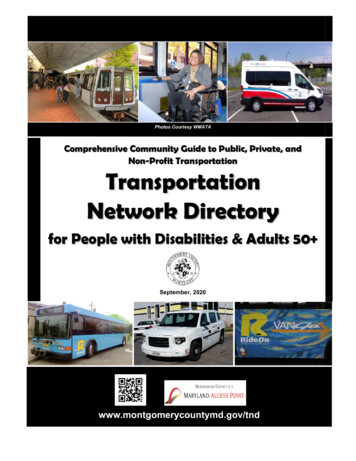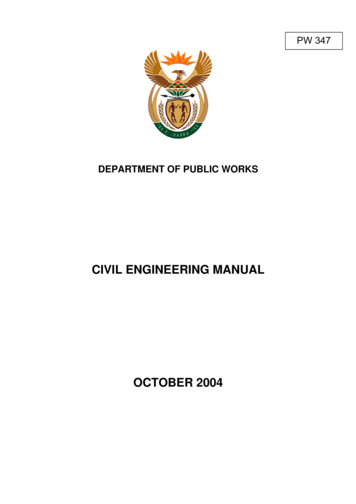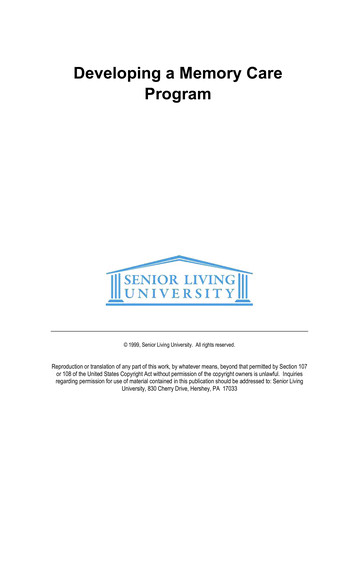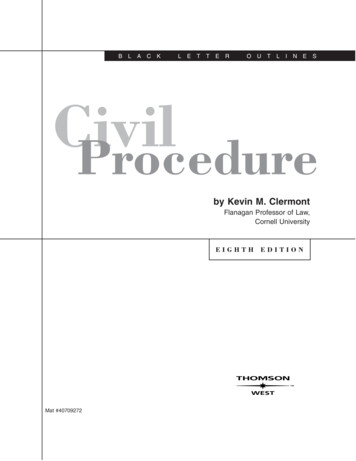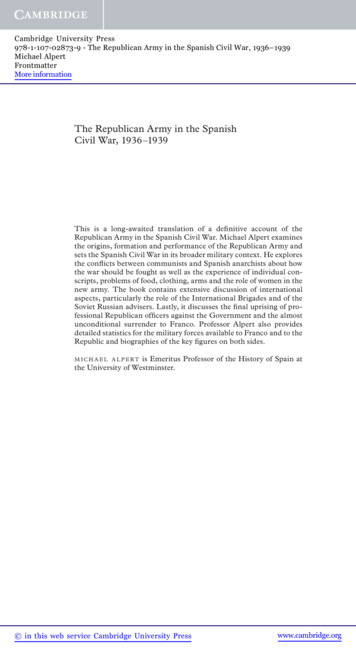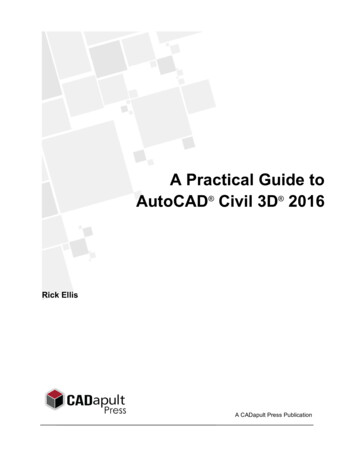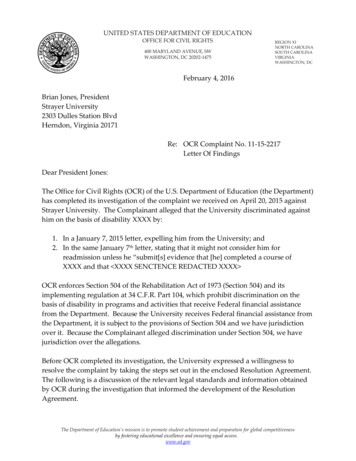
Transcription
UNITED STATES DEPARTMENT OF EDUCATIONOFFICE FOR CIVIL RIGHTS400 MARYLAND AVENUE, SWWASHINGTON, DC 20202-1475REGION XINORTH CAROLINASOUTH CAROLINAVIRGINIAWASHINGTON, DCFebruary 4, 2016Brian Jones, PresidentStrayer University2303 Dulles Station BlvdHerndon, Virginia 20171Re: OCR Complaint No. 11-15-2217Letter Of FindingsDear President Jones:The Office for Civil Rights (OCR) of the U.S. Department of Education (the Department)has completed its investigation of the complaint we received on April 20, 2015 againstStrayer University. The Complainant alleged that the University discriminated againsthim on the basis of disability XXXX by:1. In a January 7, 2015 letter, expelling him from the University; and2. In the same January 7th letter, stating that it might not consider him forreadmission unless he “submit[s] evidence that [he] completed a course ofXXXX and that XXXX SENCTENCE REDACTED XXXX OCR enforces Section 504 of the Rehabilitation Act of 1973 (Section 504) and itsimplementing regulation at 34 C.F.R. Part 104, which prohibit discrimination on thebasis of disability in programs and activities that receive Federal financial assistancefrom the Department. Because the University receives Federal financial assistance fromthe Department, it is subject to the provisions of Section 504 and we have jurisdictionover it. Because the Complainant alleged discrimination under Section 504, we havejurisdiction over the allegations.Before OCR completed its investigation, the University expressed a willingness toresolve the complaint by taking the steps set out in the enclosed Resolution Agreement.The following is a discussion of the relevant legal standards and information obtainedby OCR during the investigation that informed the development of the ResolutionAgreement.The Department of Education’s mission is to promote student achievement and preparation for global competitivenessby fostering educational excellence and ensuring equal access.www.ed.gov
Page 2 of 5 – OCR Complaint No. 11-15-2217Letter of FindingsLegal StandardsThe first legal standard applicable to the allegations is that no qualified individual witha disability student shall, on the basis of disability, be excluded from participation in, bedenied the benefits of, or otherwise be subjected to discrimination in any postsecondaryeducation program or activity of a recipient. 34 C.F.R. §104.43(a). An individual with adisability, within the meaning of Section 504, is any individual who has a physical orXXXX impairment that substantially limits the individual in one or more major lifeactivities, has a record of such an impairment, or is regarded by a recipient as havingsuch an impairment. In the context of postsecondary education, a qualified individual(or student) with a disability is any person with a disability who meets the academicand technical standards requisite to admission to or participation in a recipient’seducation program or activity.The second applicable legal standard is that recipients are not required to permit anindividual to participate in or benefit from their services, programs, or activities whenthat individual poses a direct threat to the health or safety of others. The analysis of theregulation implementing Title II of the Americans with Disabilities Act of 1990 (Title II)at 28 C.F.R. Part 35,1 includes the following guidance on determining whether anindividual poses a direct threat to others.The determination that a person poses a direct threat to the health or safety ofothers may not be based on generalizations or stereotypes about the effects of aparticular disability. It must be based on an individualized assessment, based onreasonable judgment that relies on current medical evidence or on the bestavailable objective evidence, to determine: the nature, duration, and severity ofthe risk; the probability that the potential injury will actually occur; and whetherreasonable modifications of policies, practices, or procedures will mitigate therisk. This is the test established by the Supreme Court in Arline. Such an inquiryis essential if the law is to achieve its goal of protecting . . . individuals [withdisabilities] from discrimination based on prejudice, stereotypes, or unfoundedfear, while giving appropriate weight to legitimate concerns, such as the need toavoid exposing others to significant health and safety risks.Appendix A to 28 C.F.R. Part 35.Although Title II does not apply to the University because it is not a “public entity,” the Title IIregulation, regulatory analysis and case law do inform decisions OCR makes under Section 504(and vice-versa).1
Page 3 of 5 – OCR Complaint No. 11-15-2217Letter of FindingsAnalysisThe evidence establishes that, on January 7, 2015, the University expelled theComplainant and imposed conditions for its consideration of his return because of “aninordinate number of email messages [the Complainant] sent to multiple staff membersthroughout Strayer University.” The stated basis for these actions was a Universitypolicy that provides, in part, that the University may “immediately remove a student if the student is a threat to any other person on University premises if the studentexhibits behavior including, but not limited to, extreme XXXX, disruptive or disorderlyconduct or any other violent or serious behavioral problem.”In that letter and subsequent communications (e.g., a January 30, 2015 email to theComplainant from the University’s Senior Vice Provost), the University required that,as a condition of it considering any request by the Complainant to re-enroll, he submitevidence demonstrating that he “completed a course of treatment with a XXXX and thatthe XXXX.We find that, in taking the above actions against the Complainant, the Universityregarded him as having a XXXX that substantially limited one or more major lifeactivities, that is, it regarded the Complainant as being an individual with a mentaldisability. We also find that the University admitted the Complainant and continued tofind him eligible to participate in its programs until the alleged discrimination tookplace, and there is no evidence indicating that he did not meet the academic andtechnical standards requisite to admission to or participation in the University’sprograms, at least until the time of the above University actions. Consequently, we findthat the Complainant was, during the time period covered by the allegations, aqualified student with a disability and are therefore protected by Section 504 for thepurposes of our consideration of the allegations.Despite the University’s perception that the Complainant had a disability, it failed,prior to expelling him and imposing conditions for its consideration of his return, toconduct an individual assessment of him and had no evidence (e.g. a XXXXSENTENCE REDACTED XXXX
Page 4 of 5 – OCR Complaint No. 11-15-2217Letter of FindingsConclusionPursuant to Section 302 of OCR’s Case Processing Manual, the University signed theenclosed Resolution Agreement on January 28, 2016 which, when fully implemented,will resolve the allegations raised in this complaint. The provisions of the Agreementare aligned with the allegations and issues raised by the Complainant and theinformation discussed above that was obtained during OCR’s investigation, and areconsistent with applicable law and regulation. OCR will monitor the University’simplementation of the Agreement until the University is in compliance with the statuteand regulation at issue in the case. Failure to implement the Agreement could result inOCR reopening the complaint.This concludes OCR’s investigation of the complaint. This letter should not beinterpreted to address the the University’s compliance with any other regulatoryprovision or to address any issues other than those addressed in this letter. This lettersets forth OCR’s determination in an individual OCR case. This letter is not a formalstatement of OCR policy and should not be relied upon, cited, or construed as such.OCR’s formal policy statements are approved by a duly authorized OCR official andmade available to the public. The Complainant may have the right to file a private suitin federal court regardless of OCR’s determination.Please be advised that the the University may not harass, coerce, intimidate,discriminate, or otherwise retaliate against an individual because that individual assertsa right or privilege under a law enforced by OCR or files a complaint, testifies, orparticipates in an OCR proceeding. If this happens, the individual may file a retaliationcomplaint with OCR.Under the Freedom of Information Act, it may be necessary to release this documentand related correspondence and records upon request. If OCR receives such a request,we will seek to protect personally identifiable information that could reasonably beexpected to constitute an unwarranted invasion of personal privacy if released, to theextent provided by law.
Page 5 of 5 – OCR Complaint No. 11-15-2217Letter of FindingsWe appreciate the University’s cooperation in the resolution of this complaint. If youhave any questions regarding this letter, please contact Peter Gelissen, the OCRattorney assigned to this case, at (202) 453-5912 or peter.gelissen@ed.gov.Sincerely,/S/Dale RhinesProgram ManagerDistrict of Columbia OfficeOffice for Civil RightsEnclosure
Strayer University 2303 Dulles Station Blvd Herndon, Virginia 20171 Re: OCR Complaint No. 11-15-2217 Letter Of Findings Dear President Jones: The Office for Civil Rights (OCR) of the U.S. Department of Education (the Department) has completed its investigation of the complaint we received on Ap

